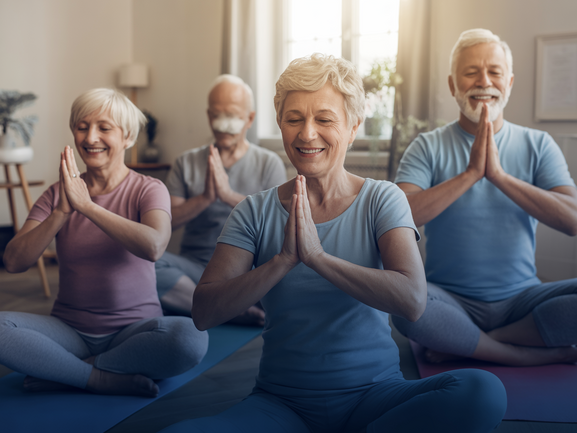Yoga for Seniors: Safe Poses to Boost Wellness After 60
Have you ever thought it might be too late to start yoga? Think again! Yoga for seniors is not only possible but incredibly beneficial for maintaining vitality, balance, and inner peace as we age. Whether you’re 60, 70, or beyond, gentle yoga practices can transform your golden years into your most vibrant ones yet.
At Vitalizen.app, we believe that wellness has no expiration date. Let’s explore how you can safely embrace yoga and gentle movement to enhance your quality of life, regardless of your current fitness level.
Why Yoga is Perfect for Seniors
Research consistently shows that yoga for older adults offers remarkable benefits. According to a study published in the Journal of Aging and Health, seniors who practice yoga regularly experience:
- Improved balance and stability – reducing fall risk by up to 40%
- Enhanced flexibility and joint mobility – keeping you moving with ease
- Better sleep quality – promoting deeper, more restorative rest
- Reduced chronic pain – particularly in the back, neck, and joints
- Lower stress and anxiety levels – supporting mental well-being
Moreover, yoga’s gentle approach makes it ideal for those managing arthritis, osteoporosis, or other age-related conditions. The beauty lies in its adaptability – every pose can be modified to suit your unique needs.
Essential Safe Yoga Poses for Seniors
Starting your yoga journey doesn’t require extreme flexibility or strength. Here are some senior yoga poses that are both safe and effective:
1. Mountain Pose (Tadasana)
This foundational pose improves posture and balance. Simply stand tall with feet hip-width apart, arms at your sides, and breathe deeply. Feel your connection to the earth while lengthening through the crown of your head.
2. Chair Pose Variation
Chair yoga is perfect for those with mobility concerns. Sit tall in a sturdy chair, place feet flat on the floor, and gently twist your torso left and right. This helps maintain spinal flexibility and core strength.
3. Cat-Cow Stretch
On hands and knees (or seated), alternate between arching and rounding your back. This gentle movement lubricates the spine and relieves tension – particularly beneficial for those who spend long hours sitting.
4. Warrior I (Modified)
Use a wall for support while stepping one foot back and raising your arms overhead. This pose strengthens legs and improves balance while being completely adaptable to your comfort level.
Remember, the key to safe yoga poses for elderly practitioners is listening to your body and never forcing any movement. Progress comes with patience and consistency, not intensity.
Creating Your Senior-Friendly Yoga Practice
Building a sustainable practice is essential for long-term success. Here’s how to get started:
Frequency and Duration
Begin with just 15-20 minutes, 2-3 times per week. As you build strength and confidence, you can gradually increase duration and frequency. Consistency trumps intensity every time.
Essential Equipment
You don’t need expensive gear to start. A yoga mat, comfortable clothing, and perhaps a chair or wall for support are sufficient. Some seniors find yoga blocks helpful for reaching the floor more easily.
Safety First
Always warm up with gentle movements and cool down with relaxation. If you have health conditions, consult your healthcare provider before beginning any new exercise routine.
The convenience of practicing at home makes yoga even more accessible. With Vitalizen’s guided classes, you can practice in your living room, moving at your own pace without the pressure of keeping up with others.
Beyond Physical Benefits: Mental and Emotional Wellness
Yoga isn’t just about physical postures – it’s a holistic practice that nurtures mind, body, and spirit. Meditation for elderly practitioners offers profound benefits:
- Cognitive enhancement – improving focus, memory, and mental clarity
- Emotional regulation – helping manage depression and anxiety
- Social connection – when practiced in groups or virtual communities
- Sense of purpose – maintaining engagement and vitality
The breathing techniques (pranayama) integrated into yoga practice are particularly beneficial for seniors, helping regulate blood pressure and promote relaxation.
Overcoming Common Concerns
Many seniors hesitate to try yoga due to misconceptions. Let’s address these concerns:
“I’m not flexible enough”
Flexibility is a result of yoga practice, not a prerequisite. Every pose can be modified, and your flexibility will naturally improve over time.
“I have joint problems”
Gentle yoga can actually help manage joint issues by improving circulation and reducing stiffness. The key is choosing appropriate modifications and avoiding painful movements.
“I’m afraid of falling”
This is why we start with seated poses and wall support. Balance exercises for seniors in yoga are designed to gradually build stability and confidence.
Frequently Asked Questions
Is yoga safe for seniors with joint problems?
Yes, when practiced mindfully. Gentle yoga can actually help manage joint issues by improving circulation and reducing stiffness. Always consult your healthcare provider first and choose modifications that feel comfortable. Chair yoga and supported poses are excellent options for those with arthritis or joint concerns.
What are the best yoga poses for beginners over 60?
Mountain Pose, Chair Pose variations, Cat-Cow stretch, and supported Warrior poses are ideal for beginners. These poses focus on posture, balance, and gentle movement while being easily modifiable. Start with seated variations and gradually progress to standing poses as you build confidence.
How often should seniors practice yoga?
Begin with 15-20 minutes, 2-3 times per week. Consistency is more important than duration – regular, gentle practice yields better results than occasional intense sessions.

